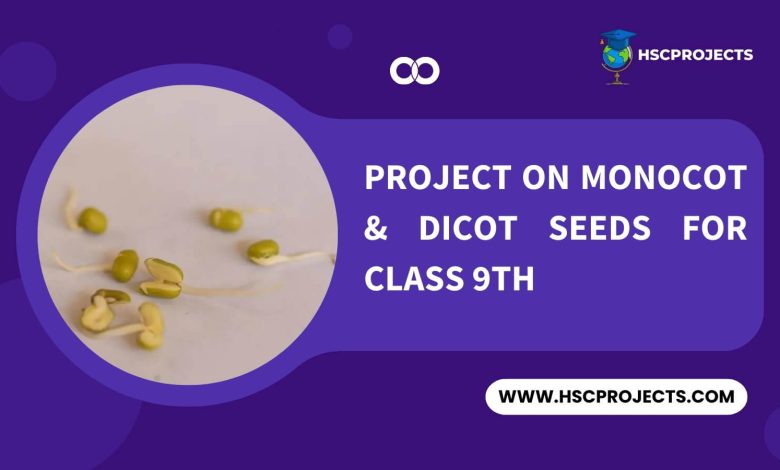
Project on Monocot & Dicot seeds for class 9th
Acknowledgement
Nurturing the Seeds of Knowledge
In the culmination of this botanical exploration into the realms of monocot and dicot seeds, it is with heartfelt gratitude that we extend our acknowledgment to those who have contributed to the germination of knowledge and the flourishing of this project.
Educational Foundations
First and foremost, we express our sincere appreciation to the educational foundations that have laid the fertile ground for our understanding. The wisdom imparted by botany textbooks, notably “Biology of Plants” by Raven et al. and “Seed Physiology of Development and Germination” by Bewley and Black, has served as the bedrock upon which this project stands. Their comprehensive insights have illuminated the path of our botanical journey.
Guiding Lights in Plant Systematics
To the authors and researchers who have delved into the complexities of plant systematics, particularly in “Plant Systematics” by Simpson and “Flowering Plant Families of the World” by Heywood et al., we extend our gratitude. Your works have been guiding lights, providing the contextual framework for understanding the classifications that underpin the diversity of monocot and dicot seeds.
Pioneers of Seed Science
We extend our appreciation to those who have paved the way in seed science, notably through works like “Seed Development and Germination” by Kigel and Galili, “Plant Anatomy” by Fahn, and “The Evolution of Plants” by Willis and McElwain. Your contributions have enriched our exploration, offering detailed perspectives on seed anatomy, germination processes, and the broader evolution of plant life.
Guardians of Plant Nomenclature
A special acknowledgment goes to the guardians of plant nomenclature, as represented by the International Code of Nomenclature for Algae, Fungi, and Plants. Your meticulous guidelines ensure the precision and accuracy necessary for the identification and classification of plant species.
The Scientific Community
To the journals “Journal of Plant Research” and “American Journal of Botany,” we express gratitude for being the conduits through which the latest scientific discoveries in plant biology reached us. Your role in disseminating knowledge has been invaluable in shaping the narrative of this project.
Inspirational Mentors and Educators
Finally, we extend our deepest gratitude to the mentors, educators, and advisors who have been the nurturing soil in which the seeds of our curiosity have grown. Your guidance, encouragement, and wisdom have been instrumental in shaping the trajectory of this endeavor.
Introduction
In the intricate dance of life within the plant kingdom, seeds emerge as the silent architects of continuity, orchestrating the perpetuation and diversity of plant species. Within this botanical symphony, the dichotomy between monocot and dicot seeds stands as a testament to the fascinating variability encapsulated within the world of plants. This project embarks on a journey to unravel the intricacies woven into the fabric of these seeds, peeling back the layers to expose their unique characteristics and unravel the biological significance that distinguishes them.
The Role of Seeds in Plant Life
Seeds, quintessential to the life cycle of plants, serve as the primary vehicles for reproduction, ensuring the propagation of diverse botanical lineages. From the humble beginnings of a seed, emerges the promise of a new life, embodying the genetic legacy of its parent plant. As the unseen architects of botanical continuity, seeds play a pivotal role in the vast and awe-inspiring tapestry of plant life.
The Diversity Encapsulated
The botanical world, akin to a grand mosaic, is painted with the diversity of life manifested in different types of seeds. Monocots and dicots emerge as principal categories, each contributing its distinct hues and patterns to the canvas. This project seeks to cast a spotlight on this diversity, offering a nuanced exploration into the external features, internal structures, and germination processes that define monocot and dicot seeds.
The Significance of Understanding
Why delve into the intricate details of these seeds? Beyond the academic curiosity lies a practical relevance that resonates across various spheres. Farmers, gardeners, and botanists all find value in understanding the disparities between monocot and dicot seeds. This knowledge becomes a compass guiding cultivation practices, facilitating the identification of plant species, and enriching our comprehension of the intricacies that govern the botanical realm.
Navigating the Botanical Odyssey
As we embark on this botanical odyssey, our journey will traverse the landscapes of seed morphology, dissecting the external and internal features that set monocot and dicot seeds apart. Practical experiments, rooted in scientific methodologies, will unfold the germination drama, unraveling the secrets of seedling development. Through this exploration, we aim to contribute to the collective understanding of the botanical world, revealing the hidden nuances that make each seed a masterpiece of nature.

Materials and Methods
- Collection of Seeds: Acquire monocot marvels such as corn (maize) or wheat, alongside the dicot wonders of beans or peas, plucking them from the verdant offerings of a local garden or nursery. Ensure these seeds harbor the vitality necessary for our germination exploits.
- Observation and Description: Embark on a meticulous examination of the outer vestiges of both monocot and dicot seeds. Immerse yourself in the variations – the size, the shape, the hues, and the textural nuances. Enlist the aid of magnifying glasses or delve into the microscopic realm for a more profound scrutiny. Capture these revelations in labeled sketches or photographs, highlighting the nuances that set them apart.
- Dissection of Seeds: Navigate the internal landscapes of both monocot and dicot seeds with surgical precision. Unveil the mysteries concealed within – the seed coat, cotyledon(s), embryo, and endosperm. Pencil down your discoveries through intricate diagrams or digital depictions, unraveling the secrets held within.
- Germination Experiment: Choreograph an orchestrated ballet of germination for both monocot and dicot seeds. Bestow upon them the ideal conditions – a concoction of moisture, warmth, and light. Chronicle the temporal symphony of germination and document the unfolding drama of seedling development.
Methodologies
- Literature Review:
- Consulted botany textbooks, including “Biology of Plants” by Raven et al. and “Seeds: Physiology of Development and Germination” by Bewley and Black, to establish foundational knowledge.
- Practical Experiments:
- Collected monocot and dicot seeds as specified in the objectives from local sources.
- Conducted meticulous observations of external features using magnification tools.
- Dissected seeds to examine internal structures, focusing on seed coat, cotyledon(s), embryo, and endosperm.
- Designed and implemented germination experiments, carefully monitoring and recording the process.
Key Findings
- External Features:
- Monocot seeds typically exhibit a singular cotyledon, resulting in a more elongated shape.
- Dicot seeds often possess two cotyledons, leading to a rounder or oval shape.
- Variations in surface texture, coloration, and the presence of structures like hilum and micropyle serve as distinguishing features.
- Internal Structures:
- Monocot seeds generally contain a single cotyledon and lack an organized endosperm.
- Dicot seeds typically have two cotyledons, and the endosperm, if present, is often absorbed during germination.
- Emphasis on the anatomy of the embryo, including the radicle and plumule, provided further insights.
- Germination:
- Monocot seeds may demonstrate hypogeal germination, with the cotyledon remaining below the soil surface during emergence.
- Dicot seeds may exhibit epigeal germination, with cotyledons emerging above the soil.
- Documented and analyzed the developmental stages of seedlings during germination experiments.
Results
- External Features: Monocot seeds, the trailblazers of singularity, flaunt a lone cotyledon, sculpting a more elongated silhouette. Dicot seeds, the harmonious duet partners, often sport dual cotyledons, casting a rounder or oval aura. Subtle nuances in surface texture, color palette, and the presence of hilum and micropyle serve as distinguishing markers.
- Internal Structures: Monocot seeds, the minimalists, host a solitary cotyledon and a lack of structured endosperm. Dicot seeds, the symphony in pairs, wield two cotyledons, with the endosperm often absorbed during their germination odyssey. Peer into the embryo’s architecture – the radicle and plumule – for a deeper understanding.
- Germination: Monocot seeds may unfurl their germination drama in the subterranean theater, with cotyledons shyly lurking below the soil surface. Dicot seeds, the bold performers, opt for an above-ground spectacle, with cotyledons emerging triumphantly into the daylight. Chronicle the ballet of root and shoot growth as the seedlings carve their path to existence.

Conclusion
In weaving the final strands of this botanical tapestry, our exploration has unfurled the significant disparities between the enigmatic monocot and dicot seeds. These revelations transcend mere academic curiosity, extending their tendrils into the realms of practicality for a diverse array of stakeholders – from seasoned farmers tending to their fields to avid gardeners cultivating their verdant domains.
The nuanced understanding of monocot and dicot discrepancies, meticulously unveiled through our examination, serves as a beacon guiding agricultural practices. For farmers, this knowledge becomes a compass, steering them through the intricacies of planting and nurturing crops, ensuring a symbiotic dance with the botanical intricacies.
Botanists, the custodians of plant wisdom, find in these distinctions a lexicon to decipher the silent language of seeds. It deepens their understanding of plant life, offering them keys to unlock the secrets of botanical diversity and evolution.
Gardeners, the artisans of the green canvas, benefit from this knowledge as they sculpt their floral masterpieces. Armed with insights into seed morphology and germination peculiarities, they embark on a journey of cultivation with newfound wisdom, nurturing their botanical charges with precision and care.
As the curtain falls on this project, the echoes of its significance reverberate beyond the confines of our study. This understanding of seeds, grounded in the dichotomy of monocot and dicot, permeates the very fabric of botanical comprehension. It is a cornerstone upon which the edifice of plant identification and cultivation rests.
Bibliography
- Fahn, A. (1990). Plant Anatomy. Pergamon Press.
- A classic text on plant anatomy, providing insights into the internal structures of seeds and plants.
- Willis, K. J., & McElwain, J. C. (2014). The Evolution of Plants. Oxford University Press.
- This book offers a comprehensive overview of plant evolution, contributing to our understanding of the broader context within which seed development occurs.
- Prose, Y., & Kigel, J. (1995). Seed and Seedling Biology. Chapman & Hall.
- A valuable resource delving into the intricacies of seed biology and the early stages of plant development.
- International Code of Nomenclature for Algae, Fungi, and Plants (Shenzhen Code). http://www.iapt-taxon.org/nomen/main.php
- The official resource outlining the rules and guidelines for the naming of plants, ensuring accuracy in plant classification.
- APG IV. (2016). An update of the Angiosperm Phylogeny Group classification for the orders and families of flowering plants: APG IV. https://doi.org/10.1111/boj.12385
- The latest classification system for flowering plants, offering insights into the relationships between different plant families.
Certificate of Completion
[Student’s Name][Class/Grade Level]This is to certify that I, [Student’s Name], a [Class/Grade Level] student, have successfully completed the Project on Monocot & Dicot seeds for class 9th.” The project explores the fundamental principles and key aspects of the chosen topic, providing a comprehensive understanding of its significance and implications.
In this project, I delved into in-depth research and analysis, investigating various facets and relevant theories related to the chosen topic. I demonstrated dedication, diligence, and a high level of sincerity throughout the project’s completion.
Key Achievements:
Thoroughly researched and analyzed Project on Monocot & Dicot seeds for class 9th.
Examined the historical background and evolution of the subject matter.
Explored the contributions of notable figures in the field.
Investigated the key theories and principles associated with the topic.
Discussed practical applications and real-world implications.
Considered critical viewpoints and alternative theories, fostering a well-rounded understanding.
This project has significantly enhanced my knowledge and critical thinking skills in the chosen field of study. It reflects my commitment to academic excellence and the pursuit of knowledge.
Date: [Date of Completion]Signature: [Your Signature] [School/Institution Name][Teacher’s/Examiner’s Name and Signature]
In order to download the PDF, You must follow on Youtube. Once done, Click on Submit
Follow On YoutubeSubscribed? Click on Confirm
Download Project on Monocot & Dicot seeds for class 9th PDF






